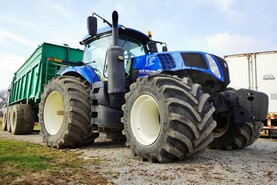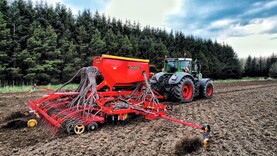With volatile milk prices, increasing milk production from grazed grass can really help the farm’s overall bottom line. Dairylink farmer Robin Clements realises this and has targeted maximising the quantity of grass grown and the utilisation of this grass by the herd as a priority for the next few months.
So what strategies is he implementing and what improvements to infrastructure has he made on his farm in Co Tyrone to help him achieve his goals?
Soil analysis
Robin soil-sampled his whole farm this winter to establish a baseline in soil fertility. After analysing the results, he was able to target any fields deficient in phosphate (P) and potash (K) with 3,000gal/acre of slurry in early March when ground conditions were good.
Robin has his own umbilical slurry spreading system, which enables him to spread when conditions are correct and which has the added advantage of minimising the compaction damage that conventional slurry tankers can cause. In Robin’s case, most of the grazing paddocks actually had the highest P and K indices (greater than NI index 2), which means that they require no chemical P&K, and straight nitrogen will suffice on this land all season, so most of the slurry and chemical P&K will be spread on the silage fields.
Groundworks
Robin has invested approximately £35,000 (€44,625) over a three-year period in farm infrastructure to help improve grass utilisation on the farm. This investment was made in drainage, roadways, fencing and water.
Approximately 15 acres have been drained with a gravel mole plough. He has extended existing laneways with 1.5km of new track, improved water supply on the farm by laying larger bore pipe and installing new drinking troughs.
Extra fencing was required to create paddocks and along new roadways.
Robin was able to curtail the cost of the new roadways due to having rock available to him on the farm, so he only had to fund excavation costs and laying the road.
Despite this significant investment, some routine maintenance was still required on roadways and paddock entrances this spring.
Robin renewed some sections of the cow roadway surface which had been washed out with heavy rain during the winter months.
The steeper sections of track were particularly affected. He covered these sections with a layer of fine stone, which was rolled in with a vibrating roller to create a solid surface.
A number of paddock entrances had also been damaged towards the end of last year and required attention. Robin dug out the topsoil closest to the gap and replaced this with stone.
Robin hopes that these improvements will assist him in getting cows out grazing in times that he otherwise wouldn’t be able to do so. He hopes that the improvements in cow lanes will reduce lameness, increase cow flow, improve grass utilisation and ultimately reduce production costs.
Fertilizer
Chemical fertilizer is an expensive input, but it nonetheless has the potential to yield a significant return on investment, especially if the extra grass produced is efficiently utilised and replaces concentrates in the diet.
Robin maintains the wet and heavy land type which is typical of his area requires longer to dry out. Because of this, there can be a two- to three-week delay in growth compared with drier farms in the region.
Robin believes that, on his farm, the growth response to fertilizer applied early in the season (before March) is poor. Consequently, he prefers to allow the soil temperature to increase above 6°C before he spreads nitrogen.
Like other farmers in his area, Robin also prefers to spread CAN, as he believes it delivers better results when used on his farm, despite it being more expensive than urea on a per unit of nitrogen basis.
Improving soil structure
In the past, Robin has used subsoiling to reduce compaction and improve drainage, and would typically practise this when reseeding fields.
Last year, Robin subsoiled two paddocks on the farm which had been compacted by cow traffic, machinery and heavy rainfall.
Both of these paddocks have improved this year, in that they dried out quicker and will be grazed shortly. Robin said he is looking forward to seeing the difference in growth rates for these fields between this year and last.
As a general rule, if compaction is a problem, it is critical to identify the depth of the compaction to know the most effective method of fixing it, for example either through subsoiling or surface aerators.
Current situation
Robin was able to graze his herd for the first time this year last week. Slurry has been spread and he will be applying 33kg/ha of nitrogen (one bag/acre of 27% CAN) this week.
The 125-cow autumn-calving herd is yielding 28 litres per day, with an average daily concentrate feeding rate of 7kg/cow.
As the herd continues to graze, Robin will reduce concentrate to the cows, particularly those that are milking less than 20 litres per day.
Robin is happy to invest in infrastructure with a good return. Achieving a 10% increase in grass utilisation on the farm this year will represent a 50t saving in purchased concentrate, equating to a saving of £10,000 (€12,750).Subsoiling paddocks helps with drainage and compaction, but is only advisable in suitable fields with limited stones/boulders.Soil analysis highlighted the reduced need for compound fertilizer on the farm, representing a significant saving, with only nitrogen required.
With volatile milk prices, increasing milk production from grazed grass can really help the farm’s overall bottom line. Dairylink farmer Robin Clements realises this and has targeted maximising the quantity of grass grown and the utilisation of this grass by the herd as a priority for the next few months.
So what strategies is he implementing and what improvements to infrastructure has he made on his farm in Co Tyrone to help him achieve his goals?
Soil analysis
Robin soil-sampled his whole farm this winter to establish a baseline in soil fertility. After analysing the results, he was able to target any fields deficient in phosphate (P) and potash (K) with 3,000gal/acre of slurry in early March when ground conditions were good.
Robin has his own umbilical slurry spreading system, which enables him to spread when conditions are correct and which has the added advantage of minimising the compaction damage that conventional slurry tankers can cause. In Robin’s case, most of the grazing paddocks actually had the highest P and K indices (greater than NI index 2), which means that they require no chemical P&K, and straight nitrogen will suffice on this land all season, so most of the slurry and chemical P&K will be spread on the silage fields.
Groundworks
Robin has invested approximately £35,000 (€44,625) over a three-year period in farm infrastructure to help improve grass utilisation on the farm. This investment was made in drainage, roadways, fencing and water.
Approximately 15 acres have been drained with a gravel mole plough. He has extended existing laneways with 1.5km of new track, improved water supply on the farm by laying larger bore pipe and installing new drinking troughs.
Extra fencing was required to create paddocks and along new roadways.
Robin was able to curtail the cost of the new roadways due to having rock available to him on the farm, so he only had to fund excavation costs and laying the road.
Despite this significant investment, some routine maintenance was still required on roadways and paddock entrances this spring.
Robin renewed some sections of the cow roadway surface which had been washed out with heavy rain during the winter months.
The steeper sections of track were particularly affected. He covered these sections with a layer of fine stone, which was rolled in with a vibrating roller to create a solid surface.
A number of paddock entrances had also been damaged towards the end of last year and required attention. Robin dug out the topsoil closest to the gap and replaced this with stone.
Robin hopes that these improvements will assist him in getting cows out grazing in times that he otherwise wouldn’t be able to do so. He hopes that the improvements in cow lanes will reduce lameness, increase cow flow, improve grass utilisation and ultimately reduce production costs.
Fertilizer
Chemical fertilizer is an expensive input, but it nonetheless has the potential to yield a significant return on investment, especially if the extra grass produced is efficiently utilised and replaces concentrates in the diet.
Robin maintains the wet and heavy land type which is typical of his area requires longer to dry out. Because of this, there can be a two- to three-week delay in growth compared with drier farms in the region.
Robin believes that, on his farm, the growth response to fertilizer applied early in the season (before March) is poor. Consequently, he prefers to allow the soil temperature to increase above 6°C before he spreads nitrogen.
Like other farmers in his area, Robin also prefers to spread CAN, as he believes it delivers better results when used on his farm, despite it being more expensive than urea on a per unit of nitrogen basis.
Improving soil structure
In the past, Robin has used subsoiling to reduce compaction and improve drainage, and would typically practise this when reseeding fields.
Last year, Robin subsoiled two paddocks on the farm which had been compacted by cow traffic, machinery and heavy rainfall.
Both of these paddocks have improved this year, in that they dried out quicker and will be grazed shortly. Robin said he is looking forward to seeing the difference in growth rates for these fields between this year and last.
As a general rule, if compaction is a problem, it is critical to identify the depth of the compaction to know the most effective method of fixing it, for example either through subsoiling or surface aerators.
Current situation
Robin was able to graze his herd for the first time this year last week. Slurry has been spread and he will be applying 33kg/ha of nitrogen (one bag/acre of 27% CAN) this week.
The 125-cow autumn-calving herd is yielding 28 litres per day, with an average daily concentrate feeding rate of 7kg/cow.
As the herd continues to graze, Robin will reduce concentrate to the cows, particularly those that are milking less than 20 litres per day.
Robin is happy to invest in infrastructure with a good return. Achieving a 10% increase in grass utilisation on the farm this year will represent a 50t saving in purchased concentrate, equating to a saving of £10,000 (€12,750).Subsoiling paddocks helps with drainage and compaction, but is only advisable in suitable fields with limited stones/boulders.Soil analysis highlighted the reduced need for compound fertilizer on the farm, representing a significant saving, with only nitrogen required. 





 This is a subscriber-only article
This is a subscriber-only article












SHARING OPTIONS: